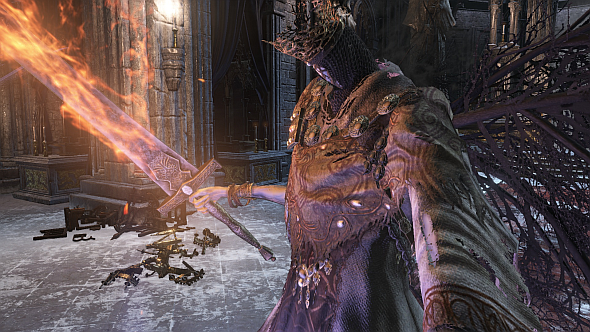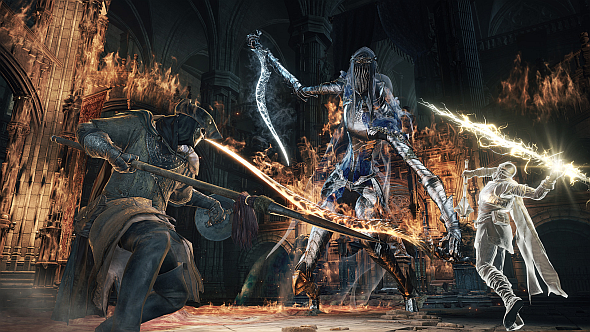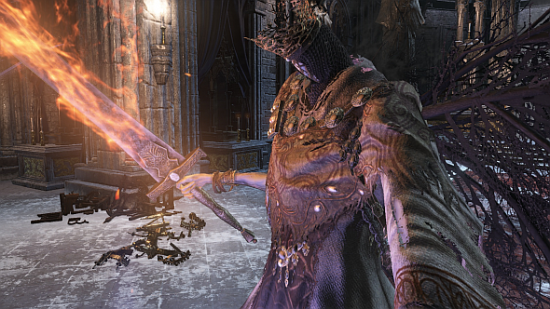Lance McDonald is a Dark Souls fan and computer engineer who digs into the game files of the Soulsborne games in search of cut or unused content. Last month he found that Ocelotte, the infant child of Dark Souls III boss Oceiros, was not always invisible, but his latest discovery is even bigger.
Return to where it all began in our Dark Souls Remastered hands-on impressions.
Once upon a time, Pontiff Sulyvahn was Dark Souls III’s final boss, not the Soul of Cinder.
Dark Souls 3 originally ended in the Untended Graves, but it wasn't the night-time version, there was 3rd version. The last boss you originally fought there was later renamed to "Pontiff Sullivahn" and moved to a different map, but Sullivahn was absolutely the last boss.
— Lance McDonald (@manfightdragon) April 18, 2018
Players would fight him in the Untended Graves area, which in the finished game was found behind a hidden wall after defeating Oceiros. Players who found it will know it as a cold and unnervingly dark place with a pitch black skybox, but according to McDonald’s findings, it wasn’t always so.
There were three states for the Untended Graves, with McDonald naming them as “‘default’, ‘eroded’, and ‘last boss’.” He implies that the one we see in the game is “the night-time version”, so perhaps one of these other states is the Cemetery of Ash – the game’s starting area, which is a daytime, properly lit copy of Untended Graves. That still leaves a third state that was “totally cut”, along with a system that would change the time of day on the fly.
Each state of the map would also have a completely different boss, with file names referring to “Champion Gundyr / OldOldHeroGunda”, “Evil Spirits / SnakeSoul”, and “Pontiff Sulyvahn / BlackOldKing”. Sulyvahn was moved to a different map (Irithyll of the Boreal Valley), while Champion Gundyr remained as the boss of the dark map – and, in weaker form, the daytime map. That leaves SnakeSoul, which McDonald says was entirely deleted, including its character file.

A lot of this tallies with a supposed leak that emerged closer to the game’s release, of which McDonald says he “can verify huge chunks”. Between that and McDonald’s own digging, Dark Souls III could have been hugely structurally different – and personally, I think I prefer the alternate version.
So much of it makes so much sense, like transitioning directly to Irithyll after the Abyss Watchers, to the Catacombs after the Greatwood, or having Aldrich spill out of his tomb in the Cathedral (like he does in the trailer). Other changes are simply appealing: having two paths into Irithyll hearkens back to the intricacy of the original game’s peerless world design. Even having a massive skeleton – Wolnir – as leader of the Mound Makers just feelsbetterthan Holy Knight Hodrick, and so much of Dark Souls is about feel.
But the best bit of the original story is having Sulyvahn as the final boss. He’s the closest the base game has to a clear villain: he betrays and overthrows the gods of Anor Londo, imprisoning Yorshka and feeding Gwyndolin to Saint Aldrich (along with many thousands of unsuspecting undead and even orphaned children). He sends his knights out on missions, giving them rings that, unbeknownst to them, will transform them into unthinking beasts. He’s an admirer of the Profaned Flame – which is antithetical to the First Flame – and an adherent of the Church of the Deep, which seeks to succeed the Age of Fire. It makes perfect sense to confront him at the game’s climax – rather than the halfway point when his crimes aren’t fully understood – and leave the anonymous, nebulous Soul of Cinder as a secret boss.

Of course, the gods of Anor Londo and the Age of Fire aren’t unambiguously good either, and therein lies the only real argument I can see for diminishing Sulyvahn. What if the player chooses to identify with his cause? Setting up the champion of the Deep as the final boss is arguably a statement in itself, and perhaps director Hidetaka Miyazaki wanted to preserve a little of the games’ famous ambiguity. But then, Dark Souls III is the end of the series – at least as we know it. Maybe Miyazaki was considering this ending precisely because it does feel a little more final.
Anyway, in my opinion, the Age of Fire is preferable to the uncertainty and corruption of the Dark and the Deep. So much of these games is subject to interpretation – which is why they’re so compelling – but “better the Devil you know” is definitely among the many messages they could be said to convey. Is it ironic if that message is clearer in thisotherversion of the game? As it were, the Devil wedon’tknow?
How very meta. How very Souls.
